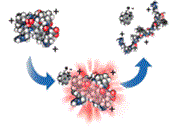Sure, one is familiar with ETD in bottom-up proteomics. In which anionic radical ions are produce by heating up polycyclic aromatic hydrocarbons to react with ESI generated peptide cations. The anion donors the electron to the cationic peptide, which induces destabilization and finally breakage of the N-C(alpha) bond to generate a fragmentation ladder consisting of c- and z-ions.
ETD works better with highly charged peptide ions and provides breakage of peptide back bone without demaging PTM information, which is a major advantage compared to CID fragmentation.
If submitting lowly charged ions or high m/z protein ions with low charge density to ETD, electron transfer does not take place at all or it takes place but the secondary protein structures, such as hydrogen bonds remain intact and one will not observe any dissociation (ETnoD).
AI-ETD combats this unaccessbility of the real ETD target utilizing an infrared laser to photo acitivate ions before submitting them to ETD. This keeps the protein unfolded and increases the ETD reaction efficiency. The results are pretty impressive - increase sequence coverage 77-96% - outperforming ETD, HCD and EThcD for intact proteins. Proteoform identification is improved as well.



Keine Kommentare:
Kommentar veröffentlichen